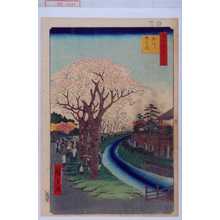Utagawa Hiroshige创作的日本版画《Blossoms on the Tama River Embankment》
标题:Blossoms on the Tama River Embankment
日期:1856
详情:更多信息...
来源:Honolulu Museum of Art
浏览所有5,476幅版画...
描述:
In Japan, it was traditionally thought that natural disasters (such as the Ansei earthquake) could be a sign of the coming of a new age, based on ancient Buddhist apocalyptic beliefs. By the mid-nineteenth century, Japan's Confucian-based society and economy could no longer maintain political and economic stability. The Tokugawa shogunate's power was diminishing. In 1853, the American Commodore Matthew Perry (1794-1858) arrived at the port of Uraga, forcing Japan to open itself to commercial trading with foreign countries for the first time in centuries. This event was a severe blow to the government, followed only two years later by the earthquake, crippling the Tokugawa shogunate's ability to maintain its authority. In reaction to these events anti-shogunate sentiment rose dramatically. Accordingly, this new interpretation of Hiroshige's series places the prints against a background in which the people of Edo might have considered the earthquake to be a sign of the impending downfall of the shogunate, as destined by the Mandate of Heaven. Since cherry blossoms traditionally mark the start of spring and a new year in Japan, their prominent (and exaggerated) inclusion in Hiroshige's prints possibly suggests a hope for change. (from Good News from Hiroshige exhibit 10/9/2008-)














